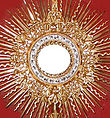- Mysterium Fidei (encyclical)
-

Papal documents
Mirae Caritatis • Dominicae Cenae • Mysterium Fidei • Mediator Dei • Ecclesia de EucharistiaOrganizations and events
Congregation of the Blessed Sacrament • Servants of the Blessed Sacrament • Perpetual Adorers • Tabernacle Societies • Eucharistic CongressNotable individuals
St. Francis • Peter Eymard • Jean Vianney • Marie Tamisier • Leo DupontEucharistic Meditators
Thérèse of Lisieux • Maria Candida • Conchita de Armida • Maria ValtortaMysterium Fidei is an encyclical letter of Pope Paul VI on the Eucharist, published in September 1965.
Mysterium Fidei was issued just as the closing session of the Second Vatican Council was beginning. Written in a stern and troubled tone, its purpose was to counter certain theological movements which he perceived were gaining ground in the Roman Catholic Church. Using terminology such as "pastoral concern" and "anxiety," the letter sends a direct and unequivocal message to the Church regarding the Eucharist. The Pope clearly feared that these novel teachings were threatening the Eucharistic piety which had marked the Catholic Church since the earliest centuries. To emphasize the centrality of the Eucharist in the Church, the Pope echoed the words of St. Ignatius of Antioch, referring to the Blessed Sacrament the "medicine of immortality."
The letter, however, received little attention as the world's interest was focused at the time was on the final works of the council fathers, particularly Lumen Gentium, issued in November of the same year at the conclusion of the Council.
Contents
Issues causing "pastoral anxiety"
Paul VI felt very strongly that certain theological currents were threatening several Catholic doctrines and practices including:
- Masses celebrated in private
- Doctrine of transubstantiation
- Eucharistic devotions
False teachings condemned
Pope Paul VI in the opening of the letter declares the following teachings are impermissible:
- "to emphasize what is called the 'communal' Mass to the disparagement of Masses celebrated in private"
- "to exaggerate the element of sacramental sign as if the symbolism, which all certainly admit in the Eucharist, expresses fully and exhausts completely the mode of Christ's presence in this sacrament"
- "to discuss the mystery of transubstantiation without mentioning ...the marvelous conversion of the whole substance of the bread into the Body and of the whole substance of the wine into the Blood of Christ, speaking rather only of what is called "transignification" and transfiguration"
- "to propose and act upon the opinion according to which, in the Consecrated Hosts which remain after the celebration of the Sacrifice of the Mass, Christ Our Lord is no longer present."
"These and similar opinions do great harm to the faith and devotion to the Divine Eucharist. And therefore, so that the hope aroused by the Council, that a flourishing of eucharistic piety which is now pervading the whole Church, be not frustrated by this spread of false opinions"
See also
External links
- Mysterium Fidei, full text
Categories:- Works by Pope Paul VI
- Eucharist (Catholic Church)
- Papal encyclicals
- 1965 works
- 1965 in religion
Wikimedia Foundation. 2010.
